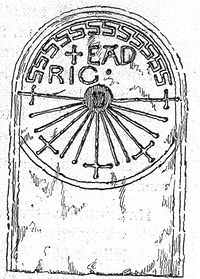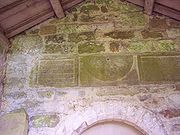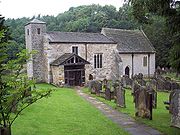
Tide (time)
Encyclopedia

Tide is an obsolete or archaic term for time, period or season.
It survives in compounds such as Yuletide, eventide, shrovetide, Eastertide, noontide, etc.
A simple noun tide was used synonymously with time
Time
Time is a part of the measuring system used to sequence events, to compare the durations of events and the intervals between them, and to quantify rates of change such as the motions of objects....
and as a unit of time with hour
Hour
The hour is a unit of measurement of time. In modern usage, an hour comprises 60 minutes, or 3,600 seconds...
in Old English and Middle English
Middle English
Middle English is the stage in the history of the English language during the High and Late Middle Ages, or roughly during the four centuries between the late 11th and the late 15th century....
, but this usage became obsolete in the 15th century and survives only in occasional poetic reference to "occasion" or "favourable, proper time".
Contemporary English narrows the application of the word to the tide
Tide
Tides are the rise and fall of sea levels caused by the combined effects of the gravitational forces exerted by the moon and the sun and the rotation of the Earth....
s of the sea.
Etymology
The term "tide" has cognates in other Germanic languages, including Dutch (tijd) and German (Zeit). In German, the word for the tides of the sea (Gezeiten) is based on the root Zeit, indicating a relationship between these two words that is no longer present to the same degree in English. The Anglo Saxon word 'tyd', from which the 'tide' is derived, means 'seasons' in a general sense.Secular use
When used on sundials the 'tides' were around three hours long, starting at 6am and ending at 6pm, the working day divided up into these four tides. Working people would know which 'tide' it was through the ringing of a church bell.The Saxons divided their sundials into 'tides' not hours, comprising 8 tides to cover day and night starting with Morgen at 04:30 to 07:30 a.m., then Daeg-mael 7.30 a.m. to 10.30 a.m.; Mid-daeg 10.30 a.m. to 1.30 p.m.; Ofanverth dagr 1.30 p.m. to 4.30 p.m.; Mid-aften 4.30 p.m. to 7.30 p.m.; Ondverth nott 7.30 p.m. to 10.30 p.m.; Mid-niht 10.30 p.m. to 1.30 a.m.; Ofanverth nott 1.30 a.m. to 4.30 a.m. , all of three hours duration.


Ecclesiastical use
Church sundials or horologes divided into tides are known as Tide Dials and they ceased to be used after the Norman Conquest. The SundialSundial
A sundial is a device that measures time by the position of the Sun. In common designs such as the horizontal sundial, the sun casts a shadow from its style onto a surface marked with lines indicating the hours of the day. The style is the time-telling edge of the gnomon, often a thin rod or a...
on the south face of the 7th-century Bewcastle
Bewcastle
Bewcastle is a large civil parish in the City of Carlisle district of Cumbria, England.According to the 2001 census the parish had a population of 411. The parish is large and includes the settlements of Roadhead, Shopford, Blackpool Gate, Roughsike and The Flatt. To the north the parish extends...
Cross is the oldest in Britain. It is at some height from the ground, and is divided by five principal lines into four spaces, the tides, according to the octaval system of the Angles. Two of these lines, viz., those for 9 a.m. and midday, are crossed at the point. The four spaces are subdivided so as to give the twelve-day hours of the Roman and ecclesiastical use. On one side of the dial there is a vertical line which touches the semicircular border at the second afternoon hour. This may be an accident, but the same kind of line is found on the dial in the crypt of Bamburgh
Bamburgh
Bamburgh is a large village and civil parish on the coast of Northumberland, England. It has a population of 454.It is notable for two reasons: the imposing Bamburgh Castle, overlooking the beach, seat of the former Kings of Northumbria, and at present owned by the Armstrong family ; and its...
church, where it marks a later hour of the day. The sundial may have been used for calculating the date of the spring equinox
Equinox
An equinox occurs twice a year, when the tilt of the Earth's axis is inclined neither away from nor towards the Sun, the center of the Sun being in the same plane as the Earth's equator...
and hence Easter
Easter
Easter is the central feast in the Christian liturgical year. According to the Canonical gospels, Jesus rose from the dead on the third day after his crucifixion. His resurrection is celebrated on Easter Day or Easter Sunday...
.

Anglo-Saxons
Anglo-Saxon is a term used by historians to designate the Germanic tribes who invaded and settled the south and east of Great Britain beginning in the early 5th century AD, and the period from their creation of the English nation to the Norman conquest. The Anglo-Saxon Era denotes the period of...
church at Corhampton
Corhampton
Corhampton is a village in Hampshire, England. It lies on the western bank of the River Meon. It forms a civil parish with Meonstoke which adjoins on the eastern bank....
, Hampshire
Hampshire
Hampshire is a county on the southern coast of England in the United Kingdom. The county town of Hampshire is Winchester, a historic cathedral city that was once the capital of England. Hampshire is notable for housing the original birthplaces of the Royal Navy, British Army, and Royal Air Force...
has a sundial with markings divided into eight three-hour 'tides'.
The ecclesiastical day has five divisions, known as the Canonical hours
Canonical hours
Canonical hours are divisions of time which serve as increments between the prescribed prayers of the daily round. A Book of Hours contains such a set of prayers....
with four three hour tides between. These were marked on the sundials as lines with crosses and indicate Prime
Prime (liturgy)
Prime, or the First Hour, is a fixed time of prayer of the traditional Divine Office , said at the first hour of daylight , between the morning Hour of Lauds and the 9 a.m. Hour of Terce. It is part of the Christian liturgies of Eastern Christianity, but in the Latin Rite it was suppressed by the...
at 6 a.m.; Terce
Terce
Terce, or Third Hour, is a fixed time of prayer of the Divine Office of almost all the Christian liturgies. It consists mainly of psalms and is said at 9 a.m. Its name comes from Latin and refers to the third hour of the day after dawn....
at 9 a.m.; Sext
Sext
Sext, or Sixth Hour, is a fixed time of prayer of the Divine Office of almost all the traditional Christian liturgies. It consists mainly of psalms and is said at noon...
at 12 p.m.; None
None (liturgy)
None , or the Ninth Hour, is a fixed time of prayer of the Divine Office of almost all the traditional Christian liturgies. It consists mainly of psalms and is said around 3 p.m...
at 3 p.m.; and finally Vespers
Vespers
Vespers is the evening prayer service in the Western Catholic, Eastern Catholic, and Eastern Orthodox, Anglican, and Lutheran liturgies of the canonical hours...
in the evening at sunset, between 4 and 6 p.m.
As mentioned by Bede
Historia ecclesiastica gentis Anglorum
The Historia ecclesiastica gentis Anglorum is a work in Latin by Bede on the history of the Christian Churches in England, and of England generally; its main focus is on the conflict between Roman and Celtic Christianity.It is considered to be one of the most important original references on...
, the length of hours and therefore the tides, was flexible at this point in history; being dependent on the length of the day as linked to the seasons. Ecclesiastics would know which 'tide' it was through the ringing of the church bell.


Romanesque architecture
Romanesque architecture is an architectural style of Medieval Europe characterised by semi-circular arches. There is no consensus for the beginning date of the Romanesque architecture, with proposals ranging from the 6th to the 10th century. It developed in the 12th century into the Gothic style,...
Church near Carlisle in England.
The Kirkdale tide dial has four principal divisions marked by five crossed lines, and subdivided by single lines; one the line marking one - fourth of the way between sunrise and noon is an incised cross; this would indicate about the hour of 9 a.m. at midwinter and 6 a.m. at midsummer, possibly the time for Prime, whilst the other lines regulated the various canonical Hours. The sundial is dedicated to one 'Hawarth' and dates between 1056 and 1065.
The Nendrum Monastic site in Northern Ireland, traditionally founded in the 5th century by St Machaoi, has a reconstructed tide dial.

